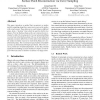Free Online Productivity Tools
i2Speak
i2Symbol
i2OCR
iTex2Img
iWeb2Print
iWeb2Shot
i2Type
iPdf2Split
iPdf2Merge
i2Bopomofo
i2Arabic
i2Style
i2Image
i2PDF
iLatex2Rtf
Sci2ools
ICRA
2006
IEEE
2006
IEEE
Surface Patch Reconstruction via Curve Sampling
This paper introduces a method that reconstructs a surface patch by sampling along three concurrent curves on the surface with a touch sensor. These data curves, each lying in a different plane, form a “skeleton” from which the patch is built in two phases. First, the Darboux frame at the curve intersection is estimated to reflect the local geometry. Second, polynomial fitting is carried out in the Darboux frame. The use of total (absolute) Gaussian curvature effectively prevents unnecessary folding of the surface normally expected to result from fitting over onedimensional data. The reconstructed patch attains remarkable accuracy as demonstrated through experiments. This work carries a promise for in-hand manipulation. It also has potential application in building accurate models for complex curved objects which can cause occlusion to a camera or a range sensor.
Related Content
| Added | 11 Jun 2010 |
| Updated | 11 Jun 2010 |
| Type | Conference |
| Year | 2006 |
| Where | ICRA |
| Authors | Yan-Bin Jia, Liangchuan Mi, Jiang Tian |
Comments (0)

